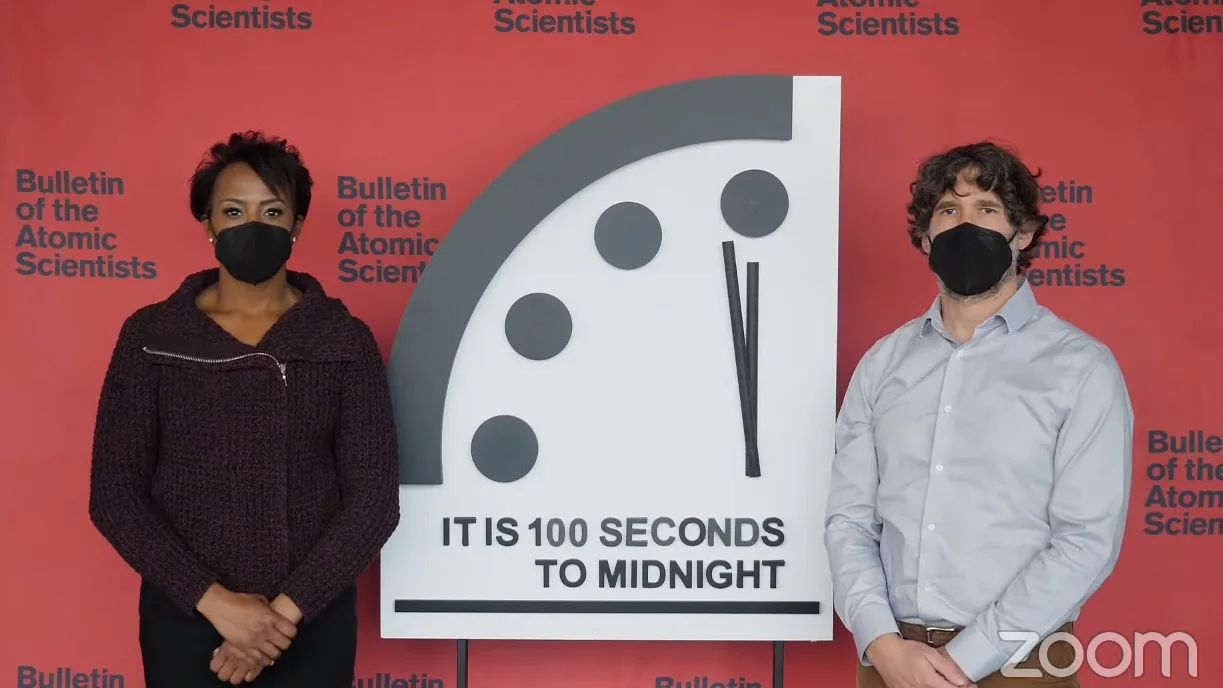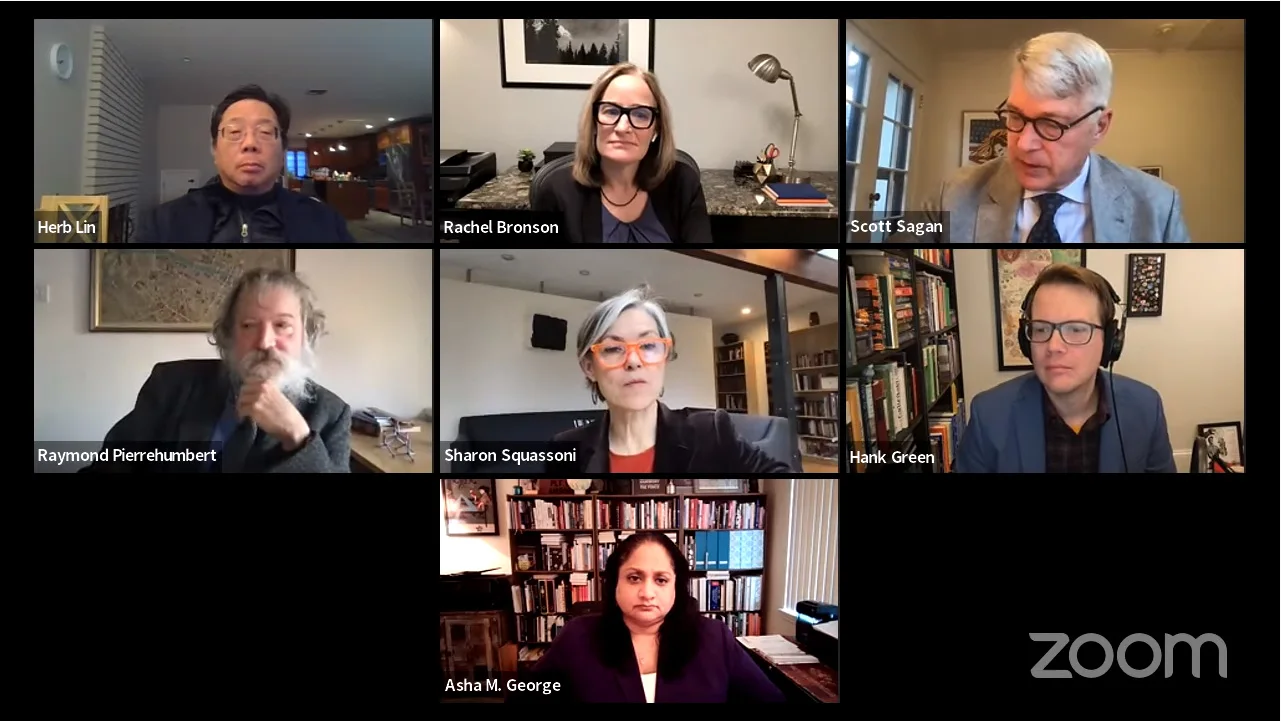
Doomsday Clock locked in at 100 seconds to midnight for third year in a row
The world remains stuck in an extremely dangerous moment, says the Bulletin of the Atomic Scientists.
Although some improvements have been noted on the political stage and with commitments to curb climate change, worrying trends around the world have kept the Doomsday Clock's hands where they have been since 2020.
In an announcement on Thursday morning, the Bulletin of Atomic Scientists revealed that the Doomsday Clock — which represents how close humanity is to annihilation — remains at 100 seconds to midnight.
Amid a mixture of positive developments and worrisome negative trends, the Bulletin's Science and Security Board concluded that the world is no safer in 2022 than it was last year or the year before.
"In view of this mixed threat environment—with some positive developments counteracted by worrisome and accelerating negative trends—the members of the Science and Security Board find the world to be no safer than it was last year at this time and therefore decide to set the Doomsday Clock once again at 100 seconds to midnight," the Bulletin said in their press release. "This decision does not, by any means, suggest that the international security situation has stabilized. On the contrary, the Clock remains the closest it has ever been to civilization-ending apocalypse because the world remains stuck in an extremely dangerous moment. In 2019 we called it the new abnormal, and it has unfortunately persisted."

Dr. Suzet McKinney (left), member of the science and security board, Principal and Director of Life Sciences for Sterling Bay, and Dr. Daniel Holz (right), co-chair of science and security board, and professor at the University of Chicago in the Departments of Physics, Astronomy & Astrophysics, the Enrico Fermi Institute, and the Kavli Institute for Cosmological Physics, present the 2022 Doomsday Clock, set at 100 seconds to midnight for the third year in a row. Credit: The Bulletin of the Atomic Scientists.
According to the Bulletin: "The Clock has become a universally recognized indicator of the world's vulnerability to catastrophe from nuclear weapons, climate change, and disruptive technologies in other domains."
In 2020, the Clock's hands were set at 100 seconds to midnight due to the expansion and modernization of nuclear arsenals around the world, the growing impacts of climate change, and a threat multiplier in the form of "the continuing corruption of the information ecosphere on which democracy and public decision-making depend."
In 2021, the hands remained fixed in place, because despite renewed commitments to limit nuclear weapons and a change of politics in Washington, D.C., there was no indication that these would result in significant improvements to world safety. Added to this were the impacts of the Covid-19 pandemic, which the Bulletin members counted as a "wake up call" to the dangers of disinformation.
Now, in 2022, we have seen some progress with U.S. politics over the past year, as well as new commitments to curb climate change at the COP26 meeting. However, these improvements represent only small steps at the moment, and there remains a large gap between the words that have been spoken by world leaders and the actions taken to back up those words. Plus, as the Bulletin notes, relations between the U.S., China, and Russia remain tense, with all three nations continuing their efforts to expand and modernize their nuclear arsenals.

Included in Thursday's Doomsday Clock announcement were (top row) Dr. Herb Lin, senior research scholar for cyber policy and security at the Center for International Security and Cooperation; Dr. Rachel Bronson, president and CEO of the Bulletin of the Atomic Scientists; Dr. Scott Sagan, Senior Fellow at the Center for International Security and Cooperation; (middle row) Dr. Raymond Pierrehumbert, Halley Professor of Physics at the University of Oxford and lead author on the IPCC Third Assessment Report; Sharon Squassoni, research professor at the Institute for International Science and Technology Policy; Hank Green, science communicator and Vlogbrother; (bottom row) Dr. Asha M. George, executive director of the Bipartisan Commission on Biodefense. Credit: Bulletin of the Atomic Scientists
The Bulletin of the Atomic Scientists was founded in 1945, by Albert Einstein and the University of Chicago scientists who helped develop the first atomic weapons in the Manhattan Project. Two years later, in 1947, the Bulletin members created the Doomsday Clock. This symbolic clock places civilization-ending apocalypse at midnight, with the hands of the clock set at a number of minutes and/or seconds from midnight to represent the threats we face in the world, and how close these threats are pushing us towards the brink.
The Doomsday Clock is set on a yearly basis by the members of Bulletin's Science and Security Board, after widely consulting the scientific communities of a number of fields of study. At its establishment, it sat at 2 minutes to midnight, reflecting the tensions at the beginning of the Cold War. In 1991, when the United States and Russia signed the agreement that ended the Cold War, the Clock was set at 17 minutes to midnight — the farthest from doomsday it has ever been.
Now, as the Clock recognizes its 75th anniversary, it remains frozen at the closest point to doomsday we've seen so far.
Bulletin scientists are calling upon leaders to immediately commit themselves to renewed cooperation, and while at the same time, asking the citizens of the world to organize and demand that their leaders quickly reduce the existential risks to human civilization.
"The doorstep of doom is no place to loiter," the concluded.






